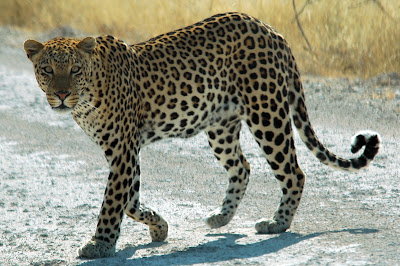LEOPARD
Physical Characteristics
The most secretive and
elusive of the large carnivores, the leopard is also the shrewdest. Pound for
pound, it is the strongest climber of the large cats and capable of killing
prey larger than itself.
Leopards come in a wide
variety of coat colors, from a light buff or tawny in warmer, drier areas to a
dark shade in deep forests. The spots, or rosettes, are circular in East
African leopards but square in southern African leopards.
Habitat
Dense bush in rocky
surroundings and forest rivers are their favorite habitats, but leopards adapt
to many places in both warm and cold climates. Their adaptability, in fact, has
helped them survive the loss of habitat to increasing human settlement.
Leopards are primarily nocturnal, usually resting during the daytime in trees
or thick bush. The spotted coat provides almost perfect camouflage.
Behavior
Leopards are solitary
creatures and predominately nocturnal. Each individual has a home range that
overlaps with its neighbors; the male's range is much larger and generally
overlaps with those of several females. Leopards continually move about their
territory, seldom staying in an area for more than two or three days at a time.
Ranges are marked with urine and claw marks and leopards announce their
presence to other leopards with a rasping cough. Leopards also growl, roar and
purr.
A litter includes two or
three cubs, whose coats appear to be smoky gray as the rosettes are not yet
clearly delineated. The female abandons her nomadic wandering until the cubs
are large enough to accompany her. She keeps them hidden for about the first 8
weeks, giving them meat when they are 6 or 7 weeks old and suckling them for 3
months or longer.
Diet
The most elusive of the
large carnivores, the leopard is a cunning, stealthy hunter, its prey ranges
from strong-scented carrion, fish, reptiles and birds to mammals such as
rodents, hares, hyraxes, warthogs, antelopes, monkeys and baboons. Both lions
and hyenas have been known to take away a leopard's kill. To prevent this,
leopards store their larger kills in trees where they can feed on them in
relative safety.
Predators and Threats
The most
widespread of the felines, leopards occur in regions across both Africa and
Asia. Indeed, their adaptability to both warm and cold climates has helped them
survive the loss of habitat caused by increasing human settlement. However,
leopards have long been preyed upon by man. Their soft, beautiful fur has been
used for clothing. The tail, claws and whiskers of the leopard are popular as
fetishes. In some areas, farmers try to exterminate them, while in others,
leopards are considered symbols of wisdom.

No comments:
Post a Comment